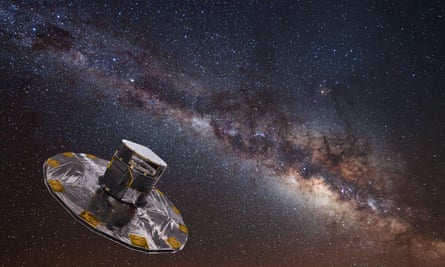Astronomers have unveiled the most detailed map to date of the Milky Way, after charting the positions of more than 1bn stars with stunning precision.
The map, based on observations from the European Space Agency’s Gaia probe, still only represents about 1% of the Milky Way’s stars, but is already 20 times more complete than any previous observations of the night sky.
Speaking at a briefing in London on Wednesday, Gerry Gilmore, the mission’s UK principle investigator, said that the mission was already transforming what we know about our home galaxy. “We don’t actually know what the Milky Way looks like,” he said. “It’s astonishingly difficult, when you’re inside something, to find out what it looks like.”
The robotic Gaia spacecraft, which launched in 2013, is fitted with a 1bn pixel camera – the largest ever in space – complete with more than 100 electronic detectors. The precision of the measurements is equivalent to measuring the width of your fingernail – but if you were in London and your finger was in Australia.
The observations have already hinted at scientific discoveries that may lie ahead - including the possibility that the Milky Way may contain more stars than the current estimate of 100bn.
Scientists originally calculated that Gaia would see about 1bn stars by the end of 2017, but this number has now been revised upwards.

Floor van Leeuwen, of the University of Cambridge, who manages Gaia’s data processing, said: “It looks very much like we underestimated the number of stars. We think we will see 2-2.5bn stars.”
However, he added that it is not obvious how this relates to the number of stars in the entire galaxy.
The camera has now made observations of the precise position and brightness of more than 1.1bn stars. Astronomers are steadily converting the data into a 3D map of the galaxy - in effect, a cosmic version of Google maps.
“Every mission to come will use this map,” said Gilmore, adding that it would also help direct ground telescopes towards objects of interest in the cosmos.

By scanning each star about 70 times, astronomers have also calculated the sideways motion of 2m stars, showing how they drift and “wobble” in the night sky. This motion information will be crucial to building up a picture of the mass distribution in the galaxy – in particular the nature of the halo of dark matter that scientists believe surrounds the visible disk of the galaxy.
“We don’t know how massive the dark matter halo is and we will know that very much more accurately,” said Gilmore. “Knowing the velocities of objects far out in the galaxy will help determine that. That will be a complete revolution.”
Gaia astronomers will also be able to spot which stars have planets, by observing the characteristic wobble of the star caused by the gravitational pull of its neighbouring planet. Scientists estimate that Gaia could identify around 70,000 new exo-planets – planets outside of our solar system – by the end of the mission, which would be a dramatic increase on the 3,500 already known, most of which were identified by Nasa’s Kepler spacecraft.
“For the first time, we’ll be able to look at the distribution of planets based on the position of parent stars,” said Gilmore. “That will be a huge step forward in understanding planetary formation.”
Alvaro Giménez, ESA’s Director of Science, said: “Today’s release gives us a first impression of the extraordinary data that await us and that will revolutionise our understanding of how stars are distributed and move across our galaxy.”